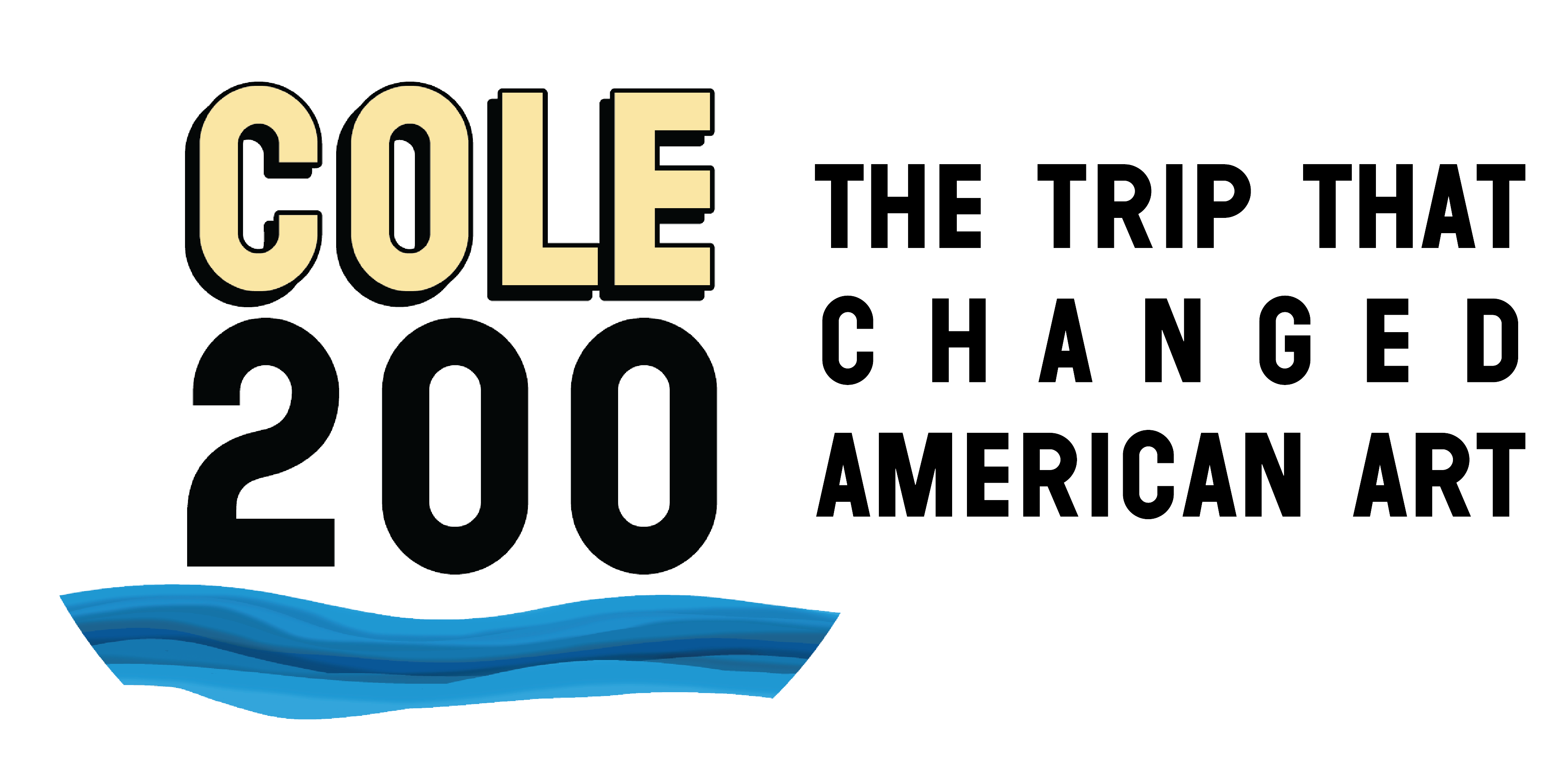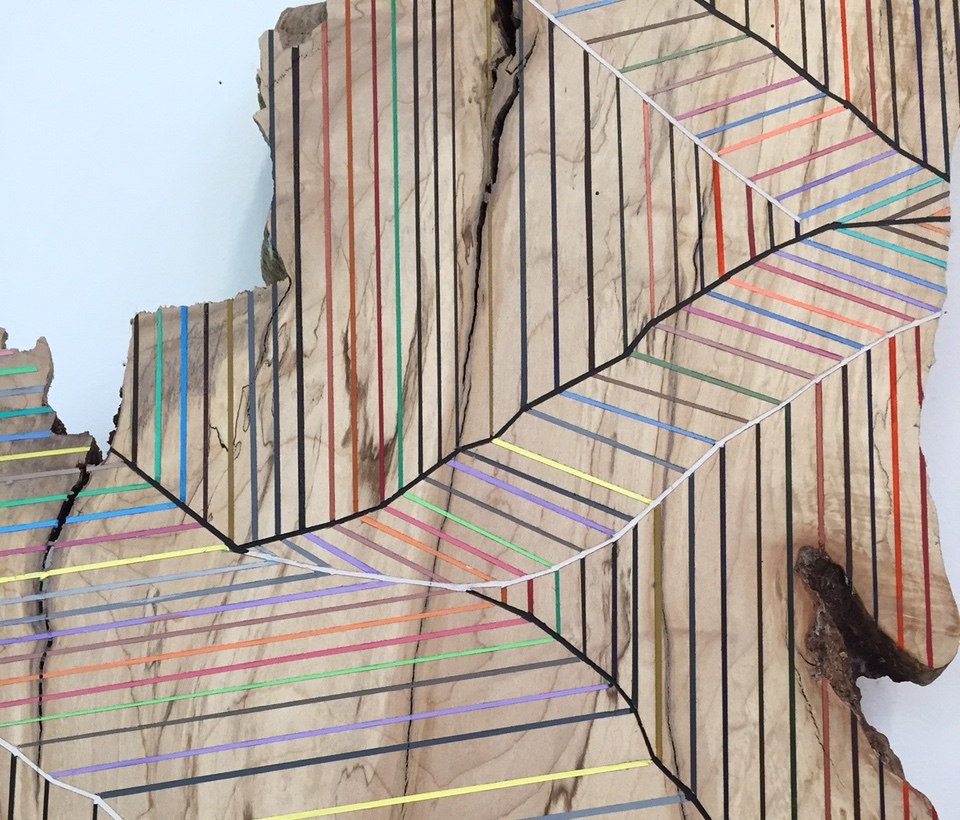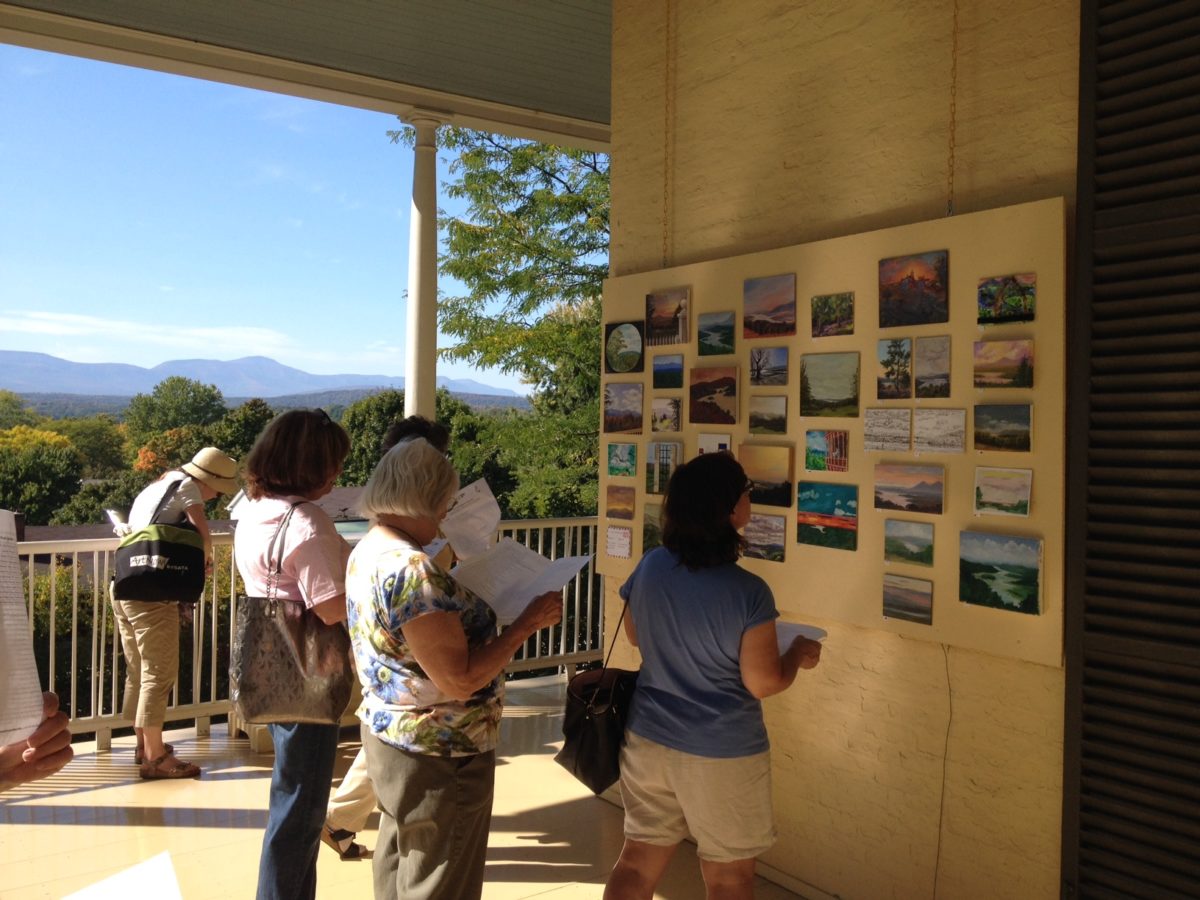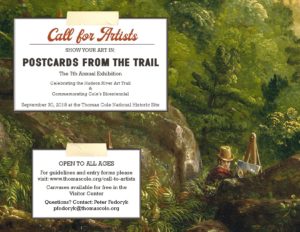Pollinator Pavillion Audio Feature Text
Transcription of the Pollinator Pavilion Audio Feature with the artists Mark Dion and Dana Sherwood. The audio is available at thomascole.org/pollinatorpavilion.
MARK DION on “The Pollinator Pavilion”
Dana and I were both very excited to have the opportunity to work at the Thomas Cole House for the [Cross Pollination] exhibition. The idea of cross-pollination is something we are very excited about. We knew very well the work of Martin Johnson Heade and the hummingbird and orchid paintings. We worked in the form of follies. We both worked and produced art that has the interaction of humans and animals, so this was the perfect kind of collaboration for us, the perfect direction for us to move in. And of course, we live very close to Catskill, so it was in many ways an ideal situation.
We thought very much about the paintings of Heade, which are just marvelous. They are just so incredibly beautiful. We thought, the only thing equally marvelous, or more marvelous, than a Heade hummingbird painting is a hummingbird itself. We wanted to construct a situation in which the viewer has an opportunity to encounter hummingbirds to actually be in a place that is shared with hummingbirds. We chose a very strange architectural mélange for the design of the gazebo, and that has a lot to do with thinking about the fantastical aspects that we see in Thomas Cole’s paintings, especially in relationship to architecture. In works like The Architect’s Dream or other pieces in which he is creating a sense of the sublime and the fantastic through his architectural representations, we want to in some way to reflect on Cole’s architectural fantasies.
DANA SHERWOOD on “The Pollinator Pavilion”
It’s no wonder that the Hudson Valley has been a draw for artists since the time of Thomas Cole. The majesty and sublime nature that surrounds the area at his time and in ours still today is full of wonder. Mark and I really wanted to capture the sense of wonder and the magical aspects of being in nature. Besides being able to go and take a walk in the forest or walk along the Hudson River here, we wanted to bring these incredible specimens that we have right here in the area, such as the hummingbird, and bring it right into the experience of the artwork where the viewer can be part of that.
While we were making this work, we had started collecting a lot of the plants that attract pollinator species, and we had filled them in our garden here in Copake. It was just incredible to go out there every morning at dawn and see the vast array and number of pollinator species, like bees, different butterflies, and in particular the hummingbirds, which of course you hear before you actually see. There is nothing like that moment of awe when you actually see them whiz by. No matter how many times you have that experience, every single time, invokes that same marvelous joy.
I think it’s worth noting that even though Mark and I have been working with nature and science for our entire careers, there’s an aspect of nurturing and growing and sustaining the natural environment, in particular the flora culture, where it brings it to entirely new level when you start thinking about sustaining the species of insect that actually make our ecosystem possible. A lot of them are virtually invisible, not to the naked eye, but as you walk through your garden, you may not notice all the insects fluttering about, and you may not recognize their significance. I know I knew this on a certain level, but there is something about bringing them into the garden and seeing how they really perform a crucial aspect to our natural ecosystem.
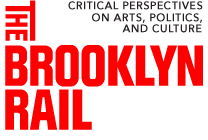
Thomas Cole’s Journey:
Atlantic Crossings
by Jason Rosenfeld
MARCH 5TH, 2018
In 2015 the painter Stephen Hannock and I curated “River Crossings” at Cedar Grove in Catskill, the home of Thomas Cole, and The Olana Partnership in Hudson, the home of Frederic Edwin Church, filling those loci of the evolution of American landscape painting with works by contemporary Hudson River Valley artists…Read Here.
Announcing OPEN HOUSE: Contemporary Art in Conversation with Cole / Inaugural exhibition by artist Jason Middlebrook
The Thomas Cole National Historic Site is pleased to announce the start of a new series of contemporary installations entitled OPEN HOUSE: Contemporary Art in Conversation with Cole. The inaugural exhibition is with artist Jason Middlebrook and will be on view August 14 – October 30. A members’ opening event will be held on August 13, 5-7 pm.
Open House: Contemporary Art in Conversation with Cole is a new series of contemporary art projects at the Thomas Cole National Historic site that explore the continued power and influence of Thomas Cole’s art and ideas. Operating from the concept that all art is contemporary, the program activates conversations between artists across the centuries. For this installation, Middlebrook is creating a site-specific exhibition inside the home of artist, Thomas Cole, in collaboration with the Thomas Cole site’s curator Kate Menconeri. This solo project, installed in conversation with works by Cole already within the house, will feature a selection of Middlebrook’s signature hardwood plank paintings and debut new works on paper, made for the occasion, that draw on Cole’s sketches of trees. Middlebrook lives and works in the Hudson Valley and has had solo shows at MASS MoCA and the New Museum, among other national and international venues.
“Bringing contemporary art into the home of the 19th-century artist Thomas Cole is incredibly exciting, as it creates the possibility of new conversations between artists and artworks across the centuries – conversations in which we can participate,” says Elizabeth Jacks, Executive Director of the Thomas Cole National Historic Site. “As it was with the installation of contemporary art here in 2015, part of the pleasure of this exhibition is the element of surprise as well as visual delight.”
“I am compelled by how the work incorporates trees as the canvas itself. The intentional use of the material overturns conventional expectations of what we might consider a landscape, a painting, or a sculpture,” says Kate Menconeri, Curator of the Thomas Cole site. “Towering and awe-inspiring, Middlebrook’s forms speak to the desire to both control or harness nature, but also honor nature’s organic geometry, abstraction, and history, as found in the sinewy lines of a tree.”
Read the exhibition press release.
About The Artist
Middlebrook paints, sculpts, draws, and creates installations that explore the relationship between nature and culture, and often blur the lines between landscape and architecture, and art and object. For his hardwood plank paintings the artist salvages lumber from a local mill and brings them back to his studio where he draws intricate lines of paint and colored patterns onto the wood. He paints the planks – maple, walnut, elm – with and against their natural grain – and in doing so intentionally acknowledges the complex stakes of human intervention in the natural environment.
“My work is broken into two parts; the first is a skin that I lay over the top of nature, somewhat like a side walk or a parking lot. The skin is just visiting, it’s covering but respecting the borders it has been given. The borders in my case are the shapes of trees, the trunks and limbs are what I choose to make paintings on; the paintings become the skin. The second aspect of my work is my reaction and interpretation of nature. This current body of work is in it’s 10th year of evolution…. In all cases the grain and the shape of wood dictate the direction of the painting which always starts with multiple drawings…”
Middlebrook’s words and work echo questions that occupied Cole almost two decades earlier, and the artists share preoccupations with our quickly changing landscape, as well as our complicated and inextricable relationship with nature, raising questions such as how to balance the man-made with the organic and examiningwhat is at stake with unchecked development.
Time will not permit me to speak of the American forest trees individually; but I must notice the elm, that paragon of beauty and shade; the maple, with its rainbow hues; and the hemlock, the sublime of trees, which rises from the gloom of the forest like a dark and ivy-mantled tower…Yet I cannot but express my sorrow that the beauty of such landscapes are quickly passing away – the ravages of the axe are daily increasing. – Thomas Cole, Essay on American Scenery, 1836
Jason Middlebrook earned a BFA from the University of California at Santa Cruz before pursuing graduate work at the San Francisco Art Institute. From 1994 to 1995, he attended the Whitney Independent Study Program in New York. Middlebrook has exhibited his work extensively, including at institutions such as the New Museum in New York, the Whitney Museum of American Art in New York, MASS MoCA in North Adams, and the Museum of Contemporary Art Chicago, among others. His work was included in the 2014 SITE Santa Fe biennial.
Meet Jason Middlebrook in our interview with the artist for the Open House Videos Series.
Program Description
Open House is collaborative by nature. Each year the Thomas Cole staff will invite one or two contemporary artists to create a site-specific project that engages with the art, writings, home and story of Thomas Cole. Projects may take the shape of an installation, a performance, a guided walk, or other format reflecting the artist’s practice and ideas. This program will seek artworks and ideas of the highest artistic merit, drawn from newly created or relevant pre-existing works, that shed light on the connections between 19th-century American art and contemporary times, and that specifically speak to the historic environments in which they are presented. That dialogue takes on a special significance because the artworks will be placed into the very spaces where Thomas Cole launched this country’s first major art movement, now known as the Hudson River School. This context offers artists working today a unique venue in which to realize a project. The goals of the project are to engage both current and new audiences with a presentation that departs from the expected “house museum” experience, to enable visitors to access the historic spaces from a new angle, to provoke new ideas about the meaning of the art and history of the mid-19th century, and to encourage audiences to confront the vast cultural shifts that distinguish Cole’s time from our own.
Project History
The Thomas Cole National Historic Site was established as a creative and flexible institution from its beginnings. With the writing of its General Management Plan in 2004, the traditional “house museum” model of a static display of decorative arts was specifically rejected in order to accommodate a variety of educational initiatives. The Thomas Cole site’s senior staff members have a background in both historic and contemporary art: the Executive Director, Elizabeth Jacks, formerly worked at the Whitney Museum of American Art, and the site’s Curator, Kate Menconeri, has worked with contemporary artists for over a decade and holds a degree from the Center for Curatorial Studies at Bard College. In 2015, the Thomas Cole site in partnership with the nearby Olana State Historic Site organized and presented an exhibition of contemporary art that spanned the two sites that face each other across the Hudson River. The exhibition, entitled “River Crossings: Contemporary Art Comes Home”, was curated by the artist Stephen Hannock and the professor Jason Rosenfeld, and featured work by 28 artists including Chuck Close, Maya Lin and Cindy Sherman, whose work was integrated into the historic interiors of the two historic sites. The exhibition drew attention to the story of this part of the Hudson Valley as the place where American art was born in the early 19th-century, a place that continues to spark creativity and innovation among artists working today. The initiative also shattered attendance records at both sites and brought unprecedented media coverage including a feature on CBS Sunday Morning.
About the Thomas Cole National Historic Site
Thomas Cole National Historic Site (TCNHS) preserves and interprets the home and studios of Thomas Cole, the founder of the Hudson River School of painting, the nation’s first major art movement. Located on 6 acres in the Hudson Valley, the site includes the 1815 Main House, 1839 Old Studio, the newly reconstructed 1846 New Studio, and several other buildings. It is a National Historic Landmark and an affiliated area of the National Park System. Following a restoration of the Main House, the TCNHS opened to the public in 2001. TCNHS activities include guided tours, exhibitions, printed publications, extensive online programs, activities for school groups, free community events, lectures, and innovative public programs such as the Hudson River School Art Trail—a map and website that enables visitors to see the nearby views that Cole painted. Each year, the TCNHS organizes a loan exhibition of Hudson River School paintings, providing a first-hand experience with the art movement that Cole founded. The goal of all programs at the TCNHS is to enable visitors to find meaning and inspiration in Thomas Cole’s life and work. The themes that Cole explored in his art and writings—such as landscape preservation and our conception of nature as a restorative power—are both historic and timely, providing the opportunity to connect to audiences with insights that are highly relevant to their own lives.
Visit
Thomas Cole’s home, studios, special exhibitions, and grounds are open May – October, Tuesday – Sunday 9:30 to 5pm. For details see: www.thomascole.org.
Cole Site Awarded Grants Totaling $612,650
December 8, 2016
We are pleased to announce that the Thomas Cole National Historic Site was awarded two New York State grants through the Regional Economic Development Council totaling $582,650, furthering the transformation of the site into a national tourism destination and economic driver for the region. A grant of $165,000 was awarded to promote the Cole Site’s new installation, the Parlors Project, opening in May 2017. The Parlors Project integrates meticulous historic restoration with interactive audio visual technology to bring to life the home of Thomas Cole and engage broad new audiences. A second grant of $417,650 was awarded to install a fire suppression system in the site’s Main House. This system will protect the recently discovered and only known example of Cole’s decorative paintings that were done directly on the walls of his home.
For the full pdf from the Regional Economic Development Council click here.
For the press release from the Thomas Cole Site click here.
December 13, 2016
We are pleased to announce that the Thomas Cole National Historic Site has been awarded an Art Works Grant of $30,000 from the National Endowment for the Arts to support the 2017 exhibition Sanford R. Gifford in the Catskills and accompanying catalogue. Sanford R. Gifford in the Catskills opens in May 2017 and will be presented in Thomas Cole’s New Studio. The exhibition is curated by Kevin J. Avery, Senior Research Scholar at the Metropolitan Museum of Art. The exhibition will highlight Gifford’s creative process and for the first time bring the original paintings to a venue just a few miles from the sites that inspired them.
For the full pdf from the National Endowment for the Arts click here.
For the press release from the Thomas Cole Site click here.
Reconstructing Thomas Cole’s New Studio
Our Executive Director, Betsy Jacks, documents the behind-the-scenes journey to recreate Thomas Cole’s self-designed New Studio.
The Grand Opening! May 2, 2016
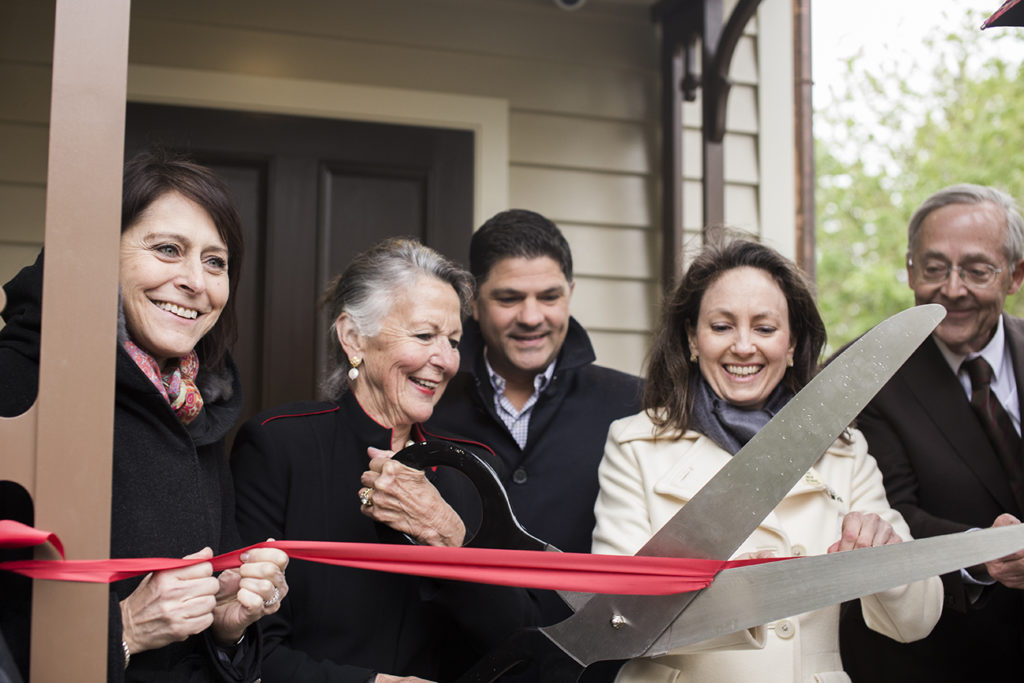
Photo by James Autery
On Sunday May 1, the grand opening and official ribbon-cutting for the New Studio took place at the Thomas Cole National Historic Site. Pictured here, left to right: Anne Miller, Chairman of the Capital Campaign Committee; Lisa Fox Martin, Chairman of the Board of Trustees, George Amadore, State Senator; Elizabeth Jacks, Executive Director; and John Mesick, Architect.
Finishing Touches November 25, 2015
At last the beautiful, hand-made, bright green shutters have arrived. The architect John Mesick designed them to be exactly like the originals, with smaller louvers on the top half of each shutter and larger louvers on the bottom half. The color was taken from two sources: one is a pencil drawing by Frederic Church from 1848 in which he indicates the colors in his hand-written notes on the drawing. The second is from a recently discovered painting of the building by Charles Herbert Moore, which will be on view inside the New Studio as part of the 2016 exhibition that will open on May 1, 2016.
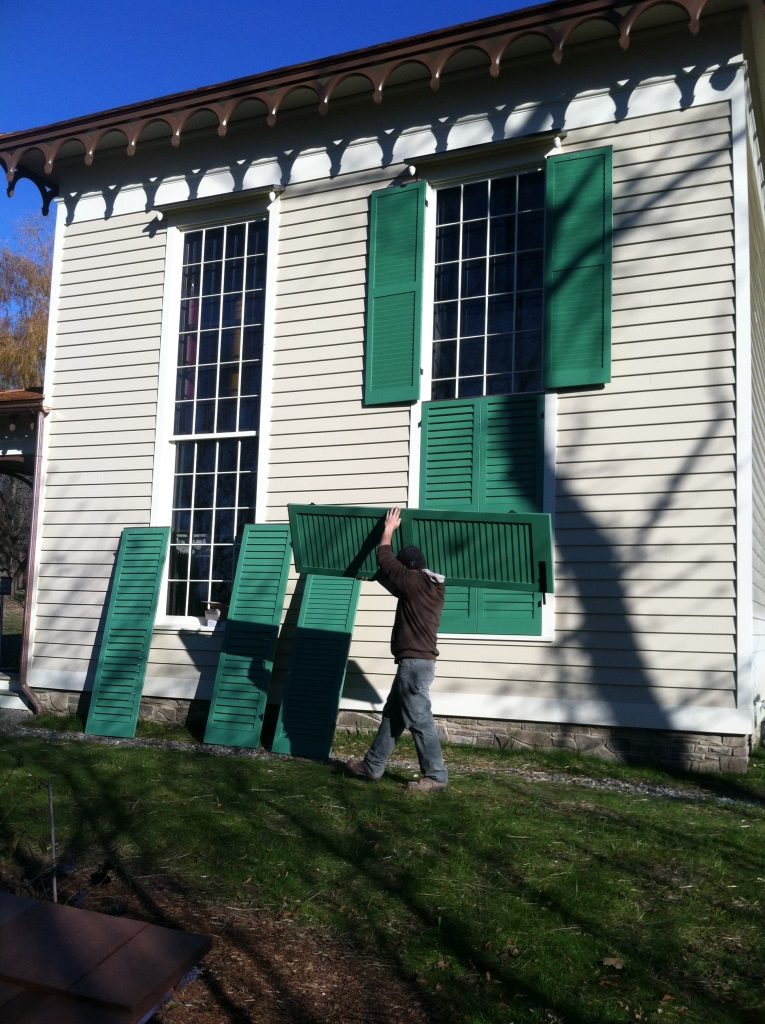
Photo by Elizabeth Jacks, November 25, 2015
Preview for Supporters Coming Up September 9, 2015
On Saturday September 19th we will open the doors of the New Studio for the first time for a special preview for everyone who has donated to the campaign. This is a truly thrilling moment for all of us. Please donate now and join this incredible celebration. Cocktails will begin at 5 pm, followed by remarks by the building’s renowned architect John I Mesick at 5:30. The event is free for anyone who has donated to the campaign at any level. Become a part of this historic moment.
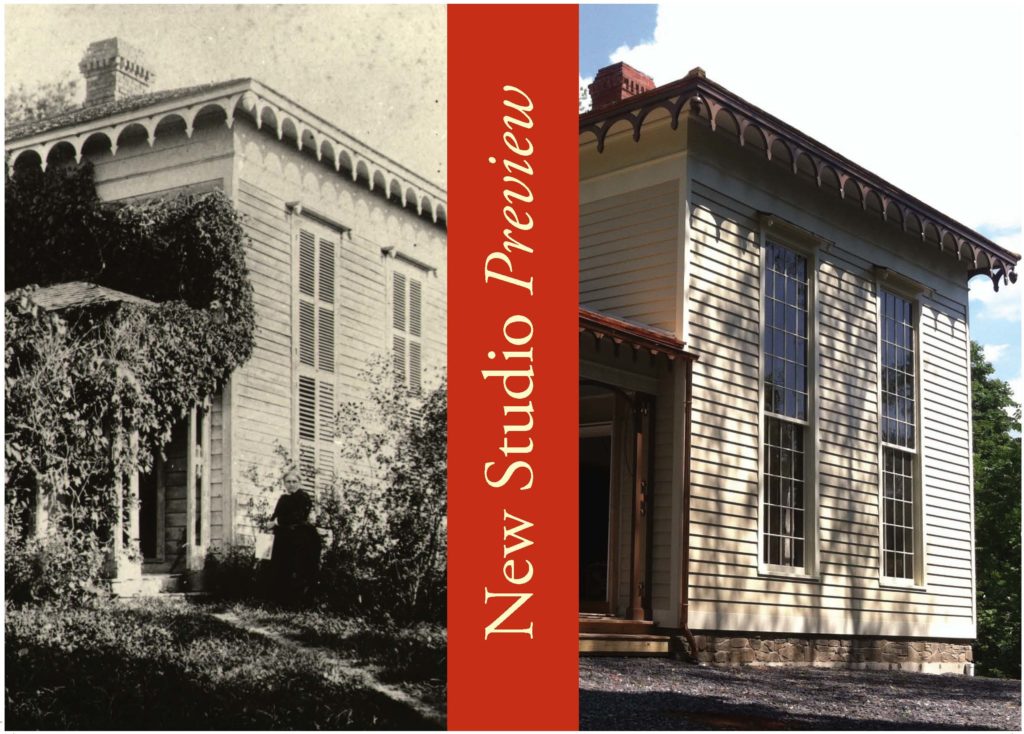
The New Studio Hits The New York Times August 10, 2015
The lovely reporter, Eve Kahn, visited us a few weeks ago and just fell in love with the New Studio. As luck would have it, the exterior scaffolding had just been taken down, and the exterior painting just completed, revealing the beautiful little building in its full glory at last. She exclaimed, “It combines grandeur with adorableness!”, which I had to agree with. Here is her wonderful article that appeared in print today: Thomas Cole’s Art Studio to Be Recreated.
Siding, trim! May 11, 2015

The construction crew of Dimensions North continued work through the weekend to get up the siding and trim along the roofline. Every day the building looks more and more like the photograph. The 2015 photo is taken from the south-east corner, while the 1900 photo is taken from the north-west.
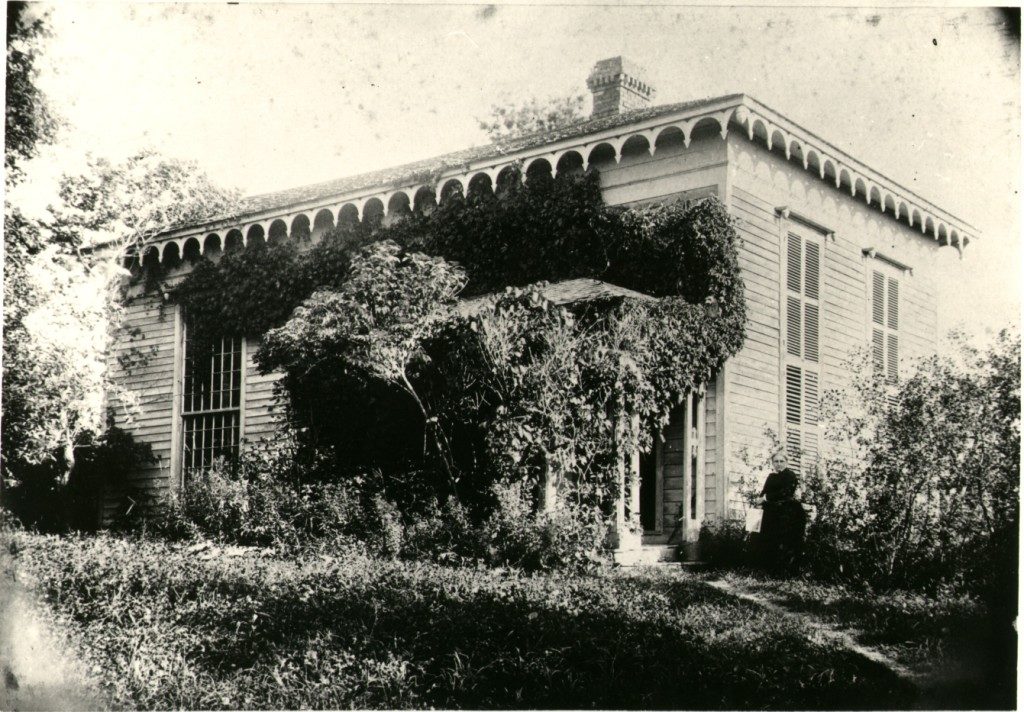
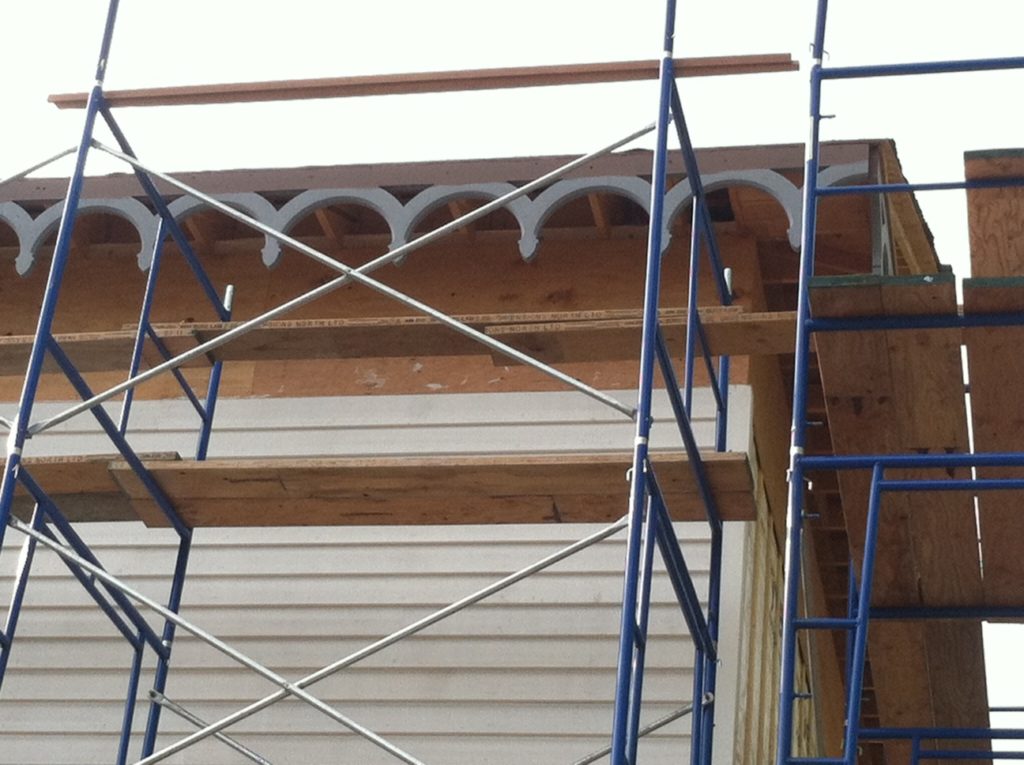
Barge Board of Solid Mahogany March 25, 2015
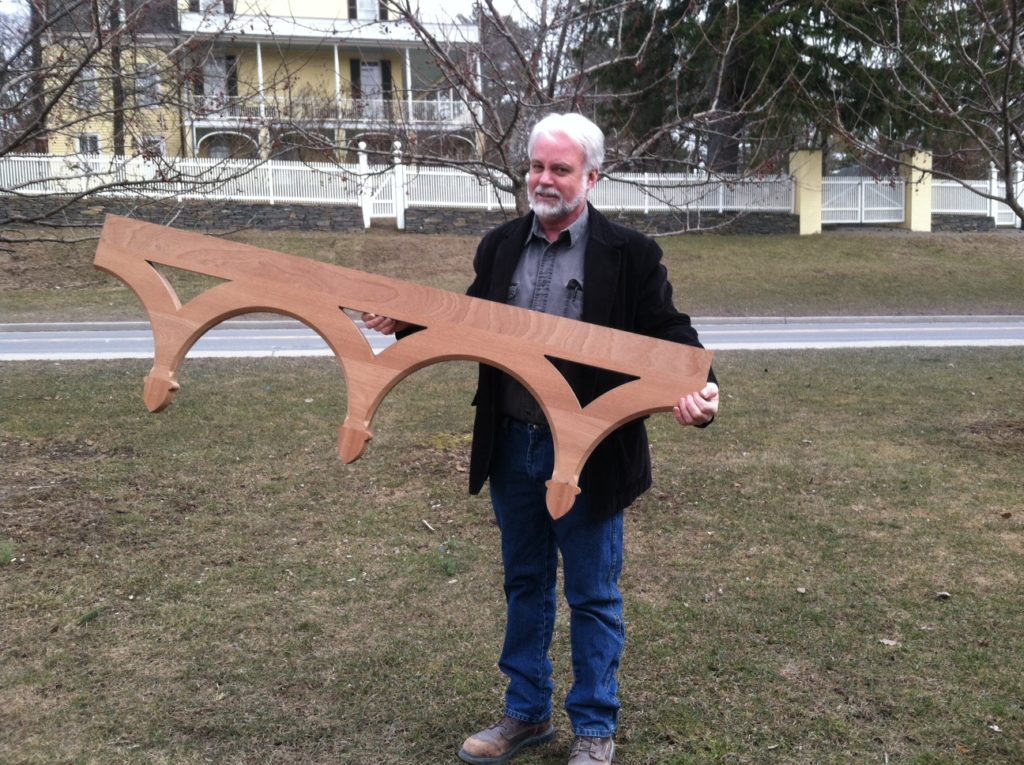
Over the winter, while the rest of us were wondering if the cold weather would ever end, the construction crew at the New Studio have been busy. With the building closed in and insulated, even the below-zero weather did not slow them down. On New Year’s Day, the cellulose insultation was blown into the wall cavities. The VESDA (Very Early Smoke Detection Apparatus) was installed, along with the security system. The stainless steel pipes for the high-pressure mist fire suppression system were laid into the attic. A large sample of the “barge board” was created and approved by the architect. In the photo at right, the head contractor Rich Rappleyea shows off the woodwork sample, made of solid mahogany so that it will last at least 50 years. Now, with the weather turning at last, the crew will turn to work on the exterior once again.
Cast in Silver January 26, 2015
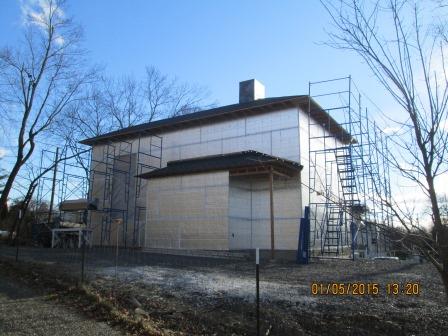
Right now, the New Studio looks as if it were made of solid silver. The building has an unusual construction: the plywood sheathing is on the inside, attached to the wooden studs from within. The insulation, therefore, was added from the outside. What you are seeing in the photo at right is the foil coating on the insulating foam board. Underneath that layer is cellulose insulation, in between the studs. Very soon, the contractor will be putting on the siding. I’m sure the siding will be beautiful, but I do like the solid silver monument that it is right now.
The Roof Takes Shape October 9, 2014
We brought in a crane this week and lifted the trusses into place. The building is taking on its final shape in this video:
Meet the Project team September 23, 2014
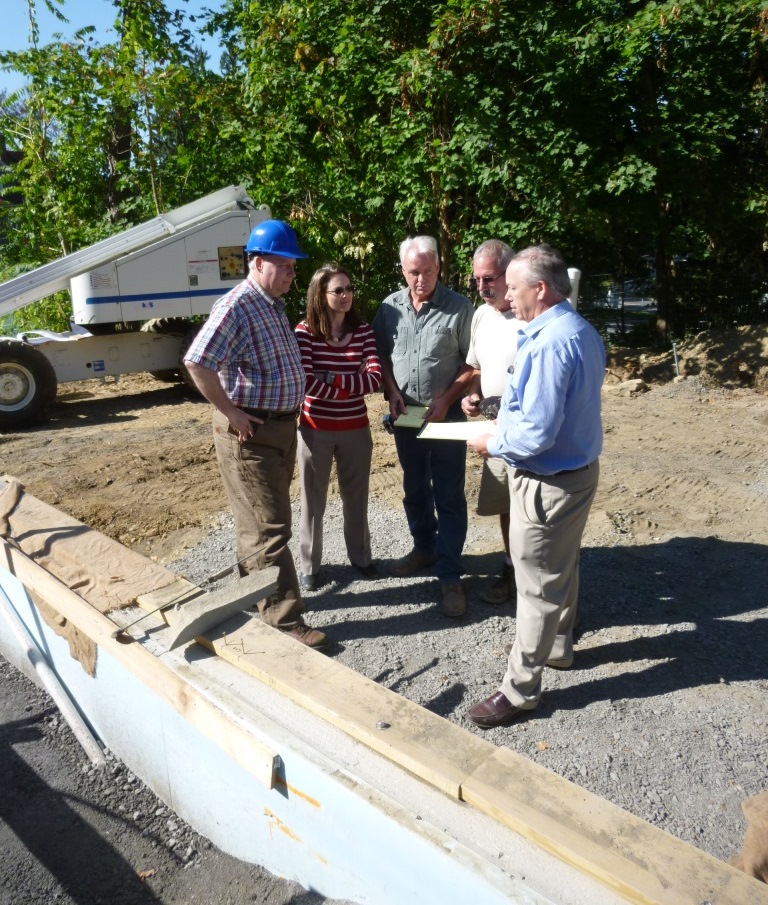
As this building goes up, a team of architects and enginners are overseeing every step. Pictured at right are (left to right):
Mark Dahl, architect from Mesick-Cohen-Wilson-Baker Architects; Betsy Jacks, Executive Director of the Thomas Cole National Historic Site; Rich Rappleyea, owner of Dimensions North, the contractor on the project; Stephen Dunn, Vice President of the Board of Trustees of the Thomas Cole National Historic Site and head of the Building Committee; and Curtis Wilsey, engineer from Quantum Engineering.
Walls! And They are Tall September 17, 2016
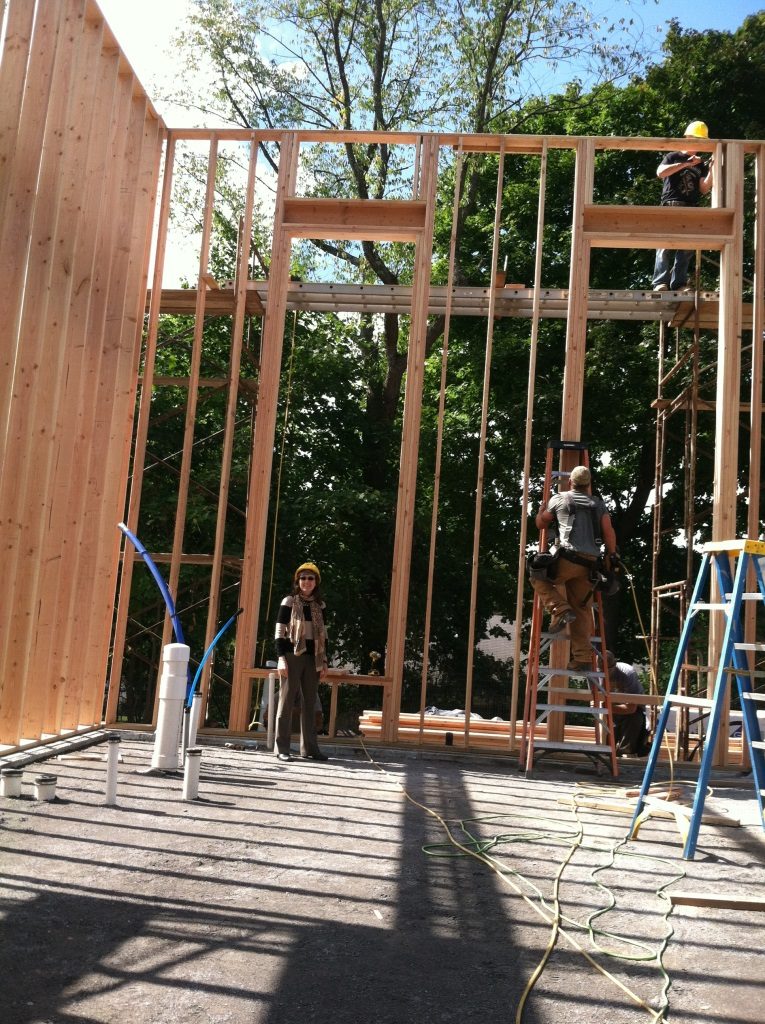
As I walked down the path to the New Studio construction site today, I was amazed to see a giant wall stretching into the sky. The building is taking shape. Two of the four walls are now up, and two enormous west-facing windows are framed. In the picture at right, I am standing in front of one of them. In Cole’s time, those windows would have framed an uninterrupted view of the Catskills. As I approached the building I was struck by how small the people looked in relation to the scale of the building, and it occurred to me that this was part of Thomas Cole’s design – the smallness of man. It was a beautiful sight. Do come and see this for yourself.
P.S. Don’t you want your name to be on the donor wall? Support the New Studio.
Thomas Cole’s Stones August 20, 2014
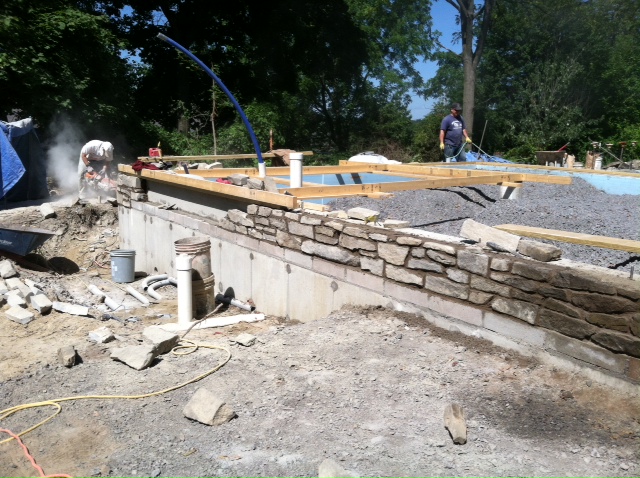
This week I am happy to report that the foundation has been poured and the stonework on the exterior is almost complete. In the photo at right, you can see the stones being cut and carefully put in place. During the excavation of the site, the original foundation stones were saved, washed and stored on pallets. A skilled stone mason is now placing them on a concrete shelf that was built into the poured concrete foundation. The concrete portion, which you can see now, will be covered with earth when the building is complete.
The Footing Is In July 14, 2014
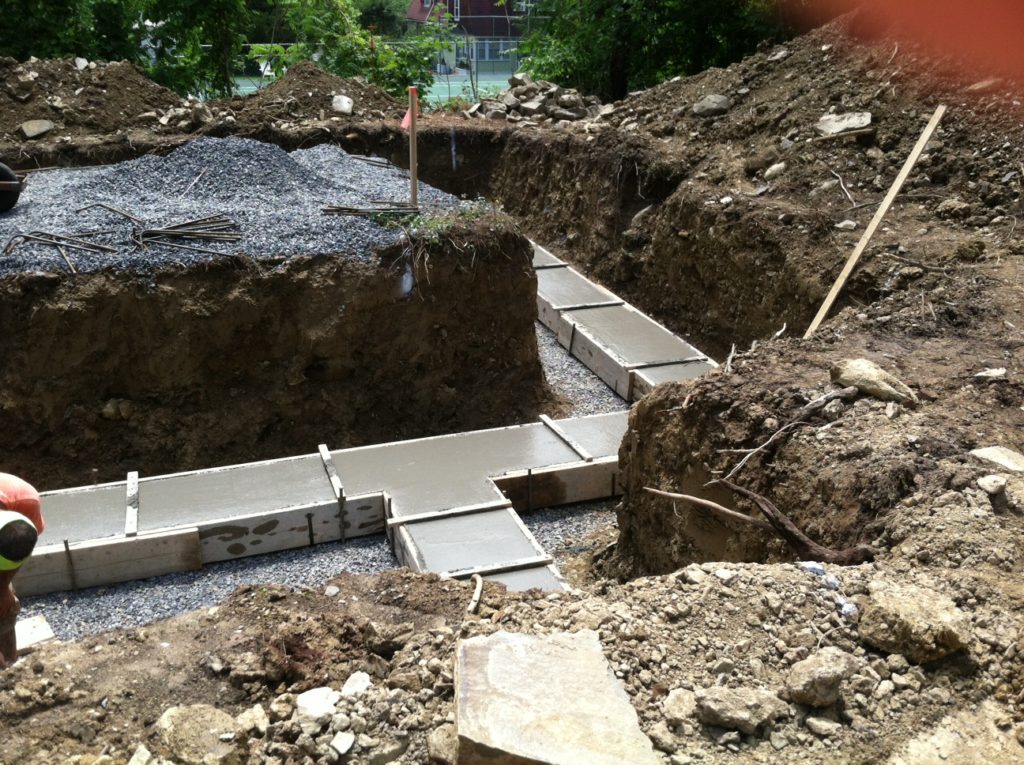
Construction on the New Studio is now in its second week. Today the concrete footing was poured in the morning so as to be sure to get it in before the afternoon thundershower. Rich Rappleyea, our GC, was there early to be sure it all moved along quickly. The crew was fast! The wood form was completely done by the time the cement truck arrived. Shown in the photo at right is the footing at the north-west corner and a portion of the entrance portico as it juts out.
We Officially Broke Ground Today on the New Studio July 3, 2014
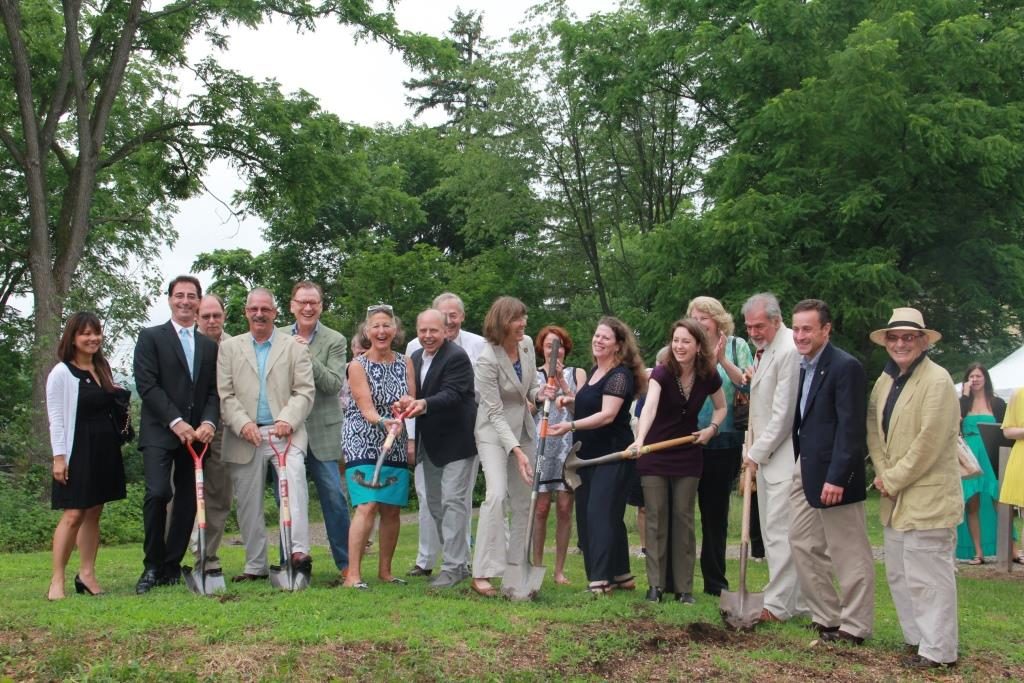
We broke ground today on the reconstruction of the New Studio! It is a day that many people have been thinking about for a long time. A groundbreaking ceremony took place on the lawn next to the foundation stones with remarks and congratulations followed by a photograph with the shovels.
In the photo above are:
Rowena Sahulee, Director of Tourism Marketing at I LOVE NY.
Vincent Seeley, Mayor, Village of Catskill.
Joseph Kosloski (behind Vincent), Legislator, Greene County.
Stephen Dunn, Trustee, Thomas Cole National Historic Site.
Warner Shook, Trustee, Thomas Cole National Historic Site.
Lisa Fox Martin, Board Chairman, Thomas Cole National Historic Site.
Stephen Shadley, Trustee, Thomas Cole National Historic Site.
John Mesick (behind Stephen), Architect.
Rose Harvey, NY State Parks Commissioner.
Nina Matis (behind the shovel), Trustee, Thomas Cole National Historic Site.
Carrie Feder, Trustee, Thomas Cole National Historic Site.
Elizabeth Jacks, Executive Director, Thomas Cole National Historic Site.
Linda Gentalen (behind Elizabeth), Trustee, Thomas Cole National Historic Site.
Hudson Talbott, Trustee, Thomas Cole National Historic Site.
Peter Lopez, NY State Assemblyman.
Michel Goldberg, Trustee, Thomas Cole National Historic Site.
Ground Breaking Event July 1, 2014
Come to the Groundbreaking Event on Thursday, July 3, 2014 at 10am
We’re on our way! Join us for the official start of the project to reconstruct Thomas Cole’s New Studio. Giving remarks at the event will be Rose Harvey, New York State Parks Commissioner; Peter Lopez, New York State Assemblyman; John Mesick, the project’s architect; as well as Betsy Jacks and Lisa Fox Martin of the Thomas Cole National Historic Site.
Historic Photographs February 12, 2014
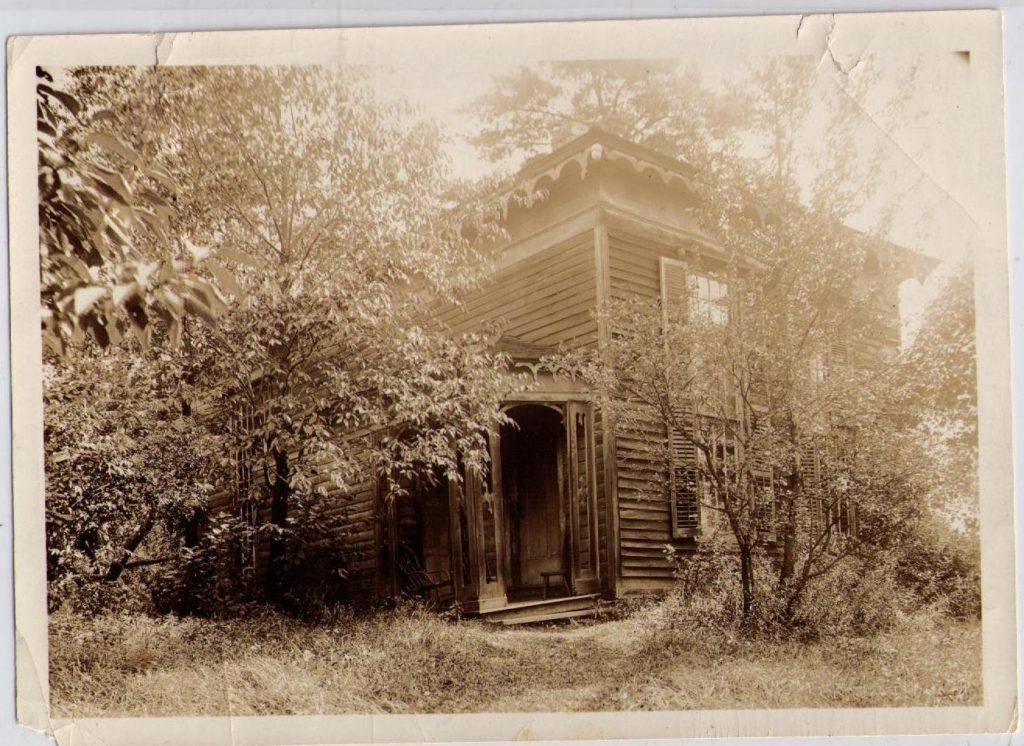
Over the past decade we’ve been collecting any and all known photographs of the New Studio building, built in 1846 and demolished in 1974. Because the demolition was so recent, we are hoping that additional photographs will surface. Do you have or know someone who has an image of the building? If so, please contact us! Here are some of the images we’ve obtained so far. The sepia-toned photograph at right shows the building in a state of extreme disrepair, but the image is not dated and we have no information about the date. Below are two other photographs, but again with no date. Both of them show the building set among the trees of an old orchard, atop a grassy knoll. All of the known images show the building from this same angle — from the northwest looking southeast. The west facade has two enormous windows that face the Catskills. The north facade has an entrance porch. We have yet to find a single image of the east facade of the building.
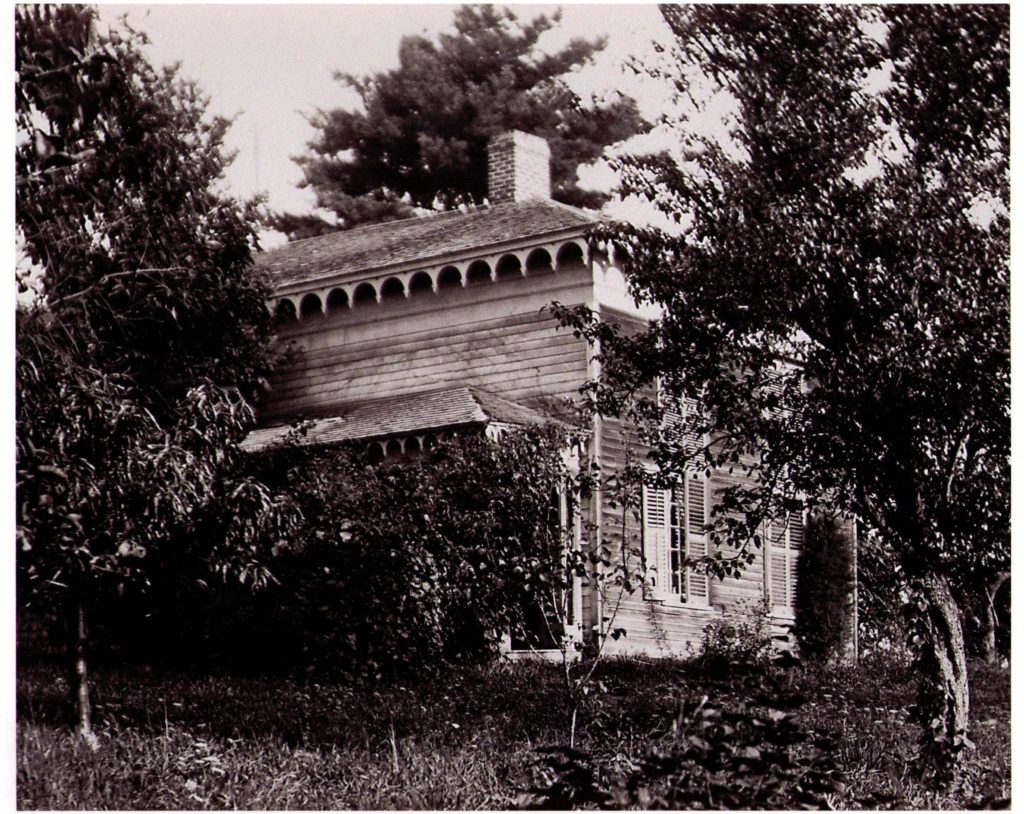
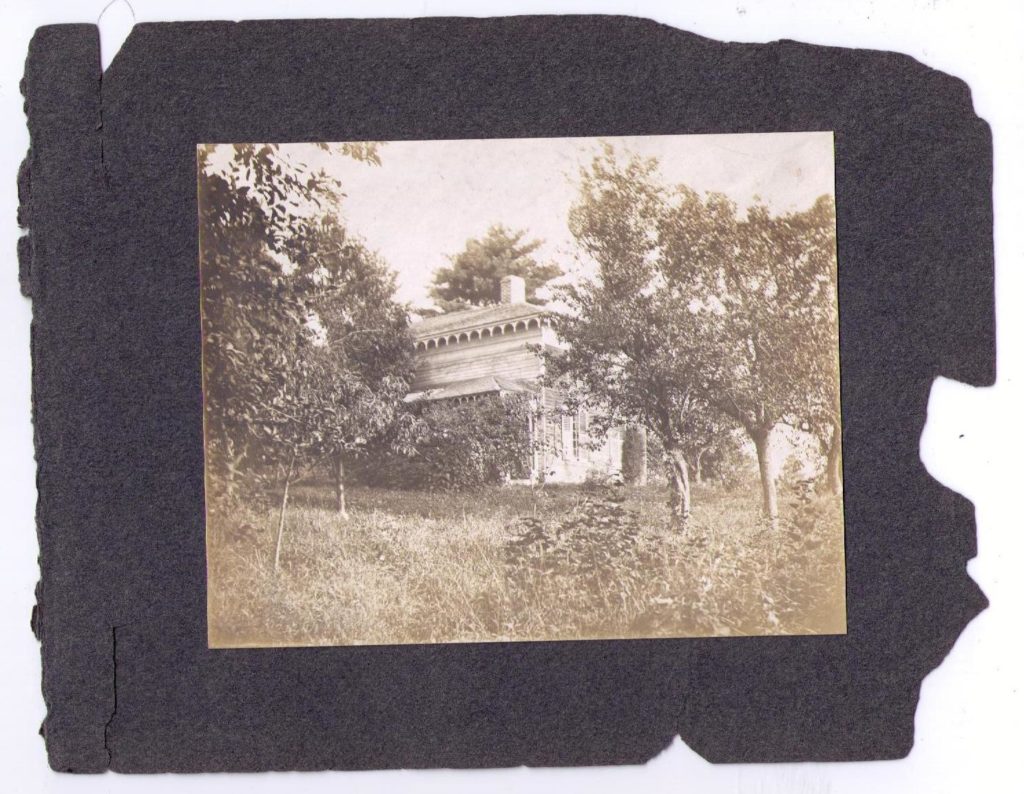
The New Studio Project Gets Underway January 15, 2014
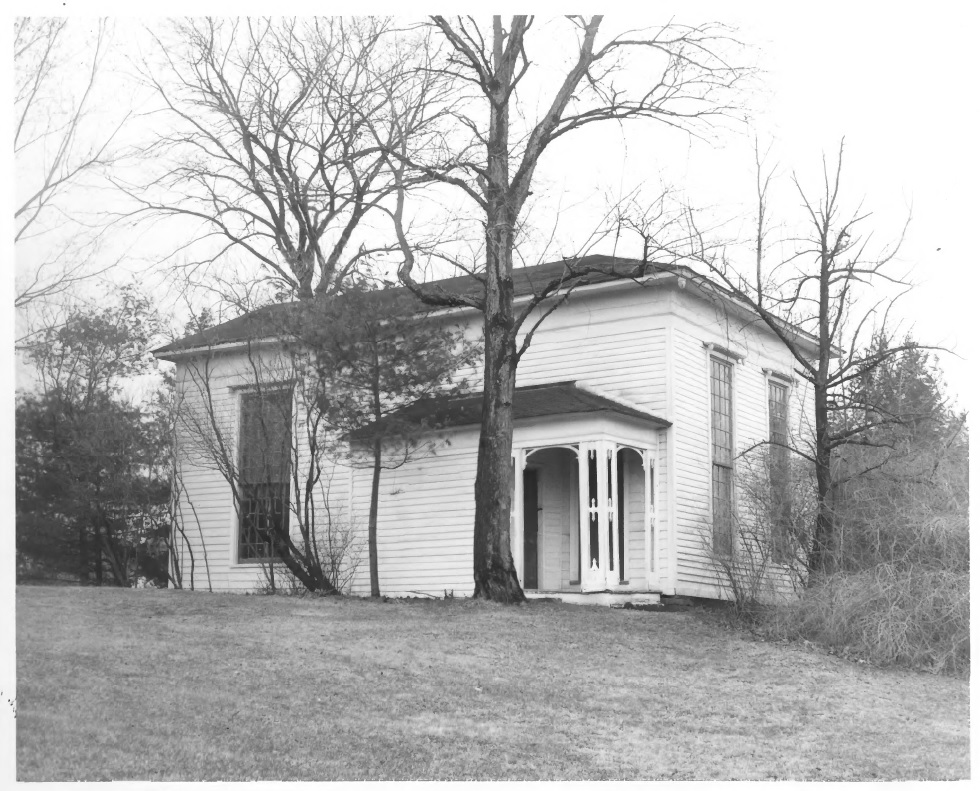
It is with great excitement that we publicly launch the project to reconstruct Thomas Cole’s New Studio! This page will be continually updated with the latest news as the project progresses, and it will serve as a source for the history of the building, surviving historic photographs, etc.
To begin, we would like to share with you a photograph of the building from 1964 — an image that we just became aware of this week. It had never been seen by our staff or the project’s architect until now. The leaves are off of the trees, allowing a clearer view of the north-facing porch and entrance. By this time, the delicate arched trim work from the eaves of the building is missing, as are the shutters on the west-facing windows, but the wooden acorn detail is still visible on the corner of the roof line.
For contrast, included here below is a photograph from around 1900. Thomas Cole’s daughter Emily can be seen near the entrance portico, giving you an idea of the scale of the building. Our reconstruction will painstakingly follow Thomas Cole’s original design, as seen below.
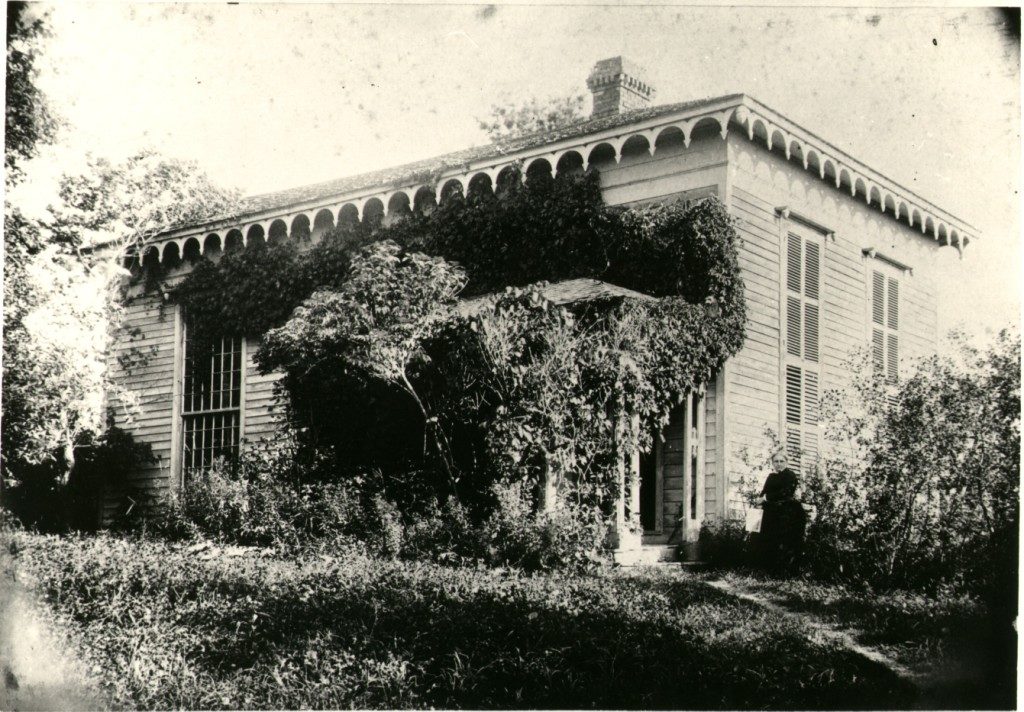
Special Event to Honor Peter Hutton Sunday, October 9, 2 pm
September 2016 / FOR IMMEDIATE RELEASE
Contact: Heather Paroubek – 518.943.7465 ext. 5 / hparoubek@thomascole.org
Thomas Cole National Historic Site
218 Spring St, P.O. Box 426
Catskill, NY 12414
Special Event for the Late Filmmaker Peter Hutton to take place on Sunday, October 9, 2 pm
Annual Fall Event to Feature Lecture by Scott MacDonald and Screenings of Hutton’s Films
Catskill, NY — Join the Thomas Cole National Historic Site as we celebrate the work of Hudson River landscape filmmaker Peter Hutton at the Arts Center Theater of Columbia-Greene Community College on Sunday, October 9 at 2 pm. During his 46 years as an independent filmmaker, Hutton, who passed away on June 25, produced a remarkable body of work that demonstrates that the legacy of Thomas Cole and Hudson River School painting is very much alive, not only in modern painting, but in cinema, as well.
Professor Scott MacDonald, Ph.D., Professor of Art History at Hamilton College and author of 14 books on independent cinema, will present this year’s Raymond Beecher Memorial Lecture: Taking Time to Look: The Landscape Films of Peter Hutton. Dr. MacDonald, whose passion for over 30 years has been introducing audiences to the worlds of alternative film and video, will show two of Hutton’s films – Landscape (for Manon) and Time and Tide – while providing an overview of Hutton’s life and work. A full-color print publication with an essay by MacDonald, who was named an Academy Film Scholar by the Academy of Motion Picture Arts and Sciences in 2012, will accompany the lecture and screening event.
Although Hutton made films all over the world, a number of his most important films focus on the same Hudson Valley scenery that captivated Thomas Cole. Hutton paid homage to Cole and the Hudson River School painters both explicitly – as in calling his 1991 film In Titan’s Goblet, a direct reference to Cole’s 1833 painting, The Titan’s Goblet – and implicitly, by forcing contemporary audiences to slow down and really look at the landscape, echoing the intent of 19th-century American landscape painters. The affinities between their artworks extend even to their chosen mediums: Hutton often slows the action on the screen to a stillness that is almost painting-like, while Cole was the most cinematic 19th-century American painter. Although Thomas Edison’s moving pictures didn’t appear until 50 years after Cole’s death, Cole was intimately familiar with panoramas, widely popular in the 19th century, and from his first paid commission – for which he painted a paired series for the Steamboat Albany – to the five-part series The Cross and the World he was working on when he died, Cole wanted to tell pictorial stories in multiple frames. Cole’s biographer, Ellwood C. Parry, III, wrote that Cole possessed “a truly cinematic imagination,” speculating that “it is not difficult to imagine that if Cole were alive today he might be making motion pictures.”
Peter Hutton began teaching at Bard College in 1985 and chaired the Film and Electronic Arts Program there for 27 years. He studied painting, sculpture, and film at the San Francisco Art Institute, where he received his BFA and MFA degrees, and paid his way by serving with the merchant marine. In 1987, Hutton was awarded Best Cinematography for his work on Phil Hartman’s feature film No Picnic at the Sundance Film Festival. In 2011, the National Film Registry of the Library of Congress selected Study of a River as one of 25 films annually chosen. Hutton has many fans locally, nationally and worldwide: in 2010, when the magazine Film Comment, which is produced by the Film Society of Lincoln Center, asked critics around the world to choose the best avant-garde films of the first decade of the new millennium, Hutton’s At Sea was voted the number #1 film of the decade, and Hutton himself one of the top filmmakers of the decade.
The Columbia-Greene Community College Theater is located at 4400 Route 23, Hudson, NY. A reception will follow the lecture. Tickets are $9 or $8 for members, available in advance or at the door. This event is sponsored in part by the National Endowment for the Arts “Imagine Your Parks” program as well as individual funders including Adele Pressman, David Gatten, Erin Espelie, Patricia O’Connor, John Knecht, James Benning, Sharon Lockhart, Robb Moss, Alfred Guzzetti, Richard Herskowitz, David Rodowick, and Patricia Zimmermann.
About Thomas Cole: As the founder of America’s first art movement, the Hudson River School, Thomas Cole (1801-1848) is a central figure in the development of American culture. When Cole made his first trip up the Hudson River in 1825, thought-leaders were searching for something distinctly American to establish the nation’s own culture as separate from that of Europe. Thomas Cole found it in the Catskill Mountain wilderness, which came to symbolize the unspoiled character of the new nation. Lionized during his lifetime and celebrated by a generation of artists who followed in his footsteps, Cole is now widely regarded as the father of American landscape painting.
About the Thomas Cole National Historic Site: The Thomas Cole National Historic Site preserves and interprets the home and studios of Thomas Cole, the founder of the Hudson River School of painting, the nation’s first art movement. Cole’s profound influence on America’s cultural landscape inspires us to engage broad audiences through educational programs that are relevant today. The Thomas Cole Historic House is an independent non-profit organization and an affiliate of the National Park Service. HOURS: Tour the Main House and Old Studio, Tues-Thurs, 10am-4pm, and Fri-Sun, 10am-1pm. Your ticket also includes the New Studio and exhibitions. Explore all the historic buildings and special exhibitions at your own pace with guides are on hand to answer questions, Fri, Sat & Sun from 2 to 5pm. The site is open May through October 30, 2016. Grounds are free and open to the public from dawn until dusk.
Contact: Heather Paroubek – 518.943.7465 ext. 5
hparoubek@thomascole.org
Thomas Cole National Historic Site
218 Spring St, P.O. Box 426
Catskill, NY 12414
Community Day!
Sunday September 18, 2016, 1-4 pm
Come one, come all to the 6th annual Community Day! From 1-4 pm, Thomas Cole’s home and the galleries will be open free of charge, with activities for the whole family. Visitors can view the Main House, New Studio and special exhibitions. There will be live music, a storyteller, art activities, a giant architectural structure to make, and free refreshments will be served. Free admission.
A special feature of the annual Community Day is the exhibition “Postcards from the Trail”, with hundreds of paintings on view and for sale. Paintings are just $100 each for adult work, and $25 each for youth work. Come early for the best selection.
Scheduled Events & Activities
1–2 pm Live Music by the Coxsackie-Athens Community Band in the music tent
1-2 pm Q&A in the main tent with Rich Rappleyea, the New Studio builder
2-3 pm Live Music by Carmen Borgia & Alison Davy in the music tent
2:30 pm Live performance of StoryCrafters under the Main House
2–4 pm Q&A in the Main House with Margaret Saliske, the conservator restoring the decorative painting in the parlors
3-4 pm Live Music by Foggy Otis and the Hudson Dusters in the music tent
3 pm Q&A in the Main House with curator Kate Menconeri about the exhibition Nature Builds/We Cover by Jason Middlebrook
3:30 pm Live performance of StoryCrafters under the Main House
3:30 pm Raffle Drawing
4:00 pm Pick up your painting from the Postcards exhibition on the West Porch
Ongoing Events & Activities: 1-4 pm
- Enjoy free admission to the Main House, Old Studio, and New Studio.
- Buy a $100 painting at the Postcards from the Trail exhibition on the West Porch.
- See the exhibition Thomas Cole: The Artist as Architect in the New Studio.
- Discover the art installation by Jason Middlebrook in the Main House and on the lawn.
- Explore the “please touch” table in the Creative Process exhibition in the Main House.
- Grab a meal at Pippy’s Food Truck.
- Enjoy free cookies and lemonade at the Visitor Center.
- Do some shopping in the gift shop.
- Add to the giant cardboard architectural project.
- Test out our new free Audio Guide, funded by AT&T.
- Add some color to the Kids’ Mural Activity.
- Toss bean-bags in the bean-bag game. Play croquet.
- Take a selfie with a super-sized Thomas Cole.
- Draw a landscape using a Camera Obscura.
- Enter the raffle at the information table for a chance to win a prize.
OPEN HOUSE: Contemporary Art in Conversation with Cole
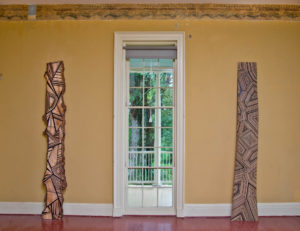
Installation view. Photo by Michael Fredericks
The Thomas Cole National Historic Site is pleased to announce the start of a new series of contemporary installations entitled OPEN HOUSE: Contemporary Art in Conversation with Cole. The inaugural exhibition was Jason Middlebrook: Nature Builds / We Cover, on view August 14 – October 30, 2016. See a video about the exhibition and listen to the artist here. The 2017 project will be announced soon.
Open House: Contemporary Art in Conversation with Cole is a new series of contemporary art projects at the Thomas Cole National Historic site that explore the continued power and influence of Thomas Cole’s art and ideas. Operating from the concept that all art is contemporary, the program activates conversations between artists across the centuries.
Program Description
Open House is collaborative by nature. Each year the Thomas Cole staff will invite one or two contemporary artists to create a site-specific project that engages with the art, writings, home and story of Thomas Cole. Projects may take the shape of an installation, a performance, a guided walk, or other format reflecting the artist’s practice and ideas. This program will seek artworks and ideas of the highest artistic merit, drawn from newly created or relevant pre-existing works, that shed light on the connections between 19th-century American art and contemporary times, and that specifically speak to the historic environments in which they are presented. That dialogue takes on a special significance because the artworks will be placed into the very spaces where Thomas Cole launched this country’s first major art movement, now known as the Hudson River School. This context offers artists working today a unique venue in which to realize a project. The goals of the project are to engage both current and new audiences with a presentation that departs from the expected “house museum” experience, to enable visitors to access the historic spaces from a new angle, to provoke new ideas about the meaning of the art and history of the mid-19th century, and to encourage audiences to confront the vast cultural shifts that distinguish Cole’s time from our own.
Project History
The Thomas Cole National Historic Site was established as a creative and flexible institution from its beginnings. With the writing of its General Management Plan in 2004, the traditional “house museum” model of a static display of decorative arts was specifically rejected in order to accommodate a variety of educational initiatives. The Thomas Cole site’s senior staff members have a background in both historic and contemporary art: the Executive Director, Elizabeth Jacks, formerly worked at the Whitney Museum of American Art, and the site’s Curator, Kate Menconeri, has worked with contemporary artists for over a decade and holds a degree from the Center for Curatorial Studies at Bard College. In 2015, the Thomas Cole site in partnership with the nearby Olana State Historic Site organized and presented an exhibition of contemporary art that spanned the two sites that face each other across the Hudson River. The exhibition, entitled “River Crossings: Contemporary Art Comes Home”, was curated by the artist Stephen Hannock and the professor Jason Rosenfeld, and featured work by 28 artists including Chuck Close, Maya Lin and Cindy Sherman, whose work was integrated into the historic interiors of the two historic sites. The exhibition drew attention to the story of this part of the Hudson Valley as the place where American art was born in the early 19th-century, a place that continues to spark creativity and innovation among artists working today. The initiative also shattered attendance records at both sites and brought unprecedented media coverage including a feature on CBS Sunday Morning.
About the Thomas Cole National Historic Site
Thomas Cole National Historic Site (TCNHS) preserves and interprets the home and studios of Thomas Cole, the founder of the Hudson River School of painting, the nation’s first major art movement. Located on 6 acres in the Hudson Valley, the site includes the 1815 Main House, 1839 Old Studio, the newly reconstructed 1846 New Studio, and several other buildings. It is a National Historic Landmark and an affiliated area of the National Park System. Following a restoration of the Main House, the TCNHS opened to the public in 2001. TCNHS activities include guided tours, exhibitions, printed publications, extensive online programs, activities for school groups, free community events, lectures, and innovative public programs such as the Hudson River School Art Trail—a map and website that enables visitors to see the nearby views that Cole painted. Each year, the TCNHS organizes a loan exhibition of Hudson River School paintings, providing a first-hand experience with the art movement that Cole founded. The goal of all programs at the TCNHS is to enable visitors to find meaning and inspiration in Thomas Cole’s life and work. The themes that Cole explored in his art and writings—such as landscape preservation and our conception of nature as a restorative power—are both historic and timely, providing the opportunity to connect to audiences with insights that are highly relevant to their own lives.
Postcards from the Trail
The 7th Annual Postcards From The Trail | OPEN CALL for ARTWORK
for exhibition at the Thomas Cole National Historic Site
Sunday, September 30, 2018
ARTWORK DUE: Friday, September 7, 2018
Please read all instruction guidelines before submitting work | In 1818, Thomas Cole arrived in the United States
and embarked on a journey to record, experience, and celebrate American landscape. The locations that he and
other artists explored in the Hudson Valley are honored today with the Hudson River School Art Trail, a program
with maps and directions allowing people to visit the places that Cole and his fellow Hudson River School artists
painted. Cole’s most well-known works reflect on the American landscape, and subjects of change, cycles, and the
natural world. In 2018, the bicentennial year of Cole’s arrival in America, we look to carry on the contemplative
spirit of the artist. For this call, we invite all artists to walk in the footsteps of Cole and to visit one of the 23 sites
along the Art Trail to make their own postcard size artwork of the same spots. Has the landscape changed since
Cole’s time, or in your own time? What about the landscape makes it matter to you, now? All interpretations are
welcome. Your submitted work of art will be a part of the 2018 pop-up exhibition at the Cole Site.
EXHIBITION
All artists who submit work according to the theme, that follows the guidelines and arrives by the deadline of
September 7 will be included in the exhibition that will take place at the Thomas Cole National Historic Site on
September 30, 2018.
GUIDELINES
+ Artists may submit original painting, drawing, work on paper, collage, photography or other medium work that
fits on a 5×7” canvas or hard board (size must be inclusive of image area, margin, and borders).
+ NOTE: A complimentary 5×7” canvas panel is available while supplies last for pick-up at the Thomas Cole
National Historic Site Visitor Center. Artists may also use their own canvas/materials. Entries must be made on
provided canvas, your own canvas, stiff board, or paper mounted on board. Loose works on paper cannot be
included. All works must be unframed, and will be hung with hook or removable, non-staining adhesive attached
directly to the back of your work.
HOW TO ENTER + TIMEFRAME
Artists may submit 1 or 2 original artworks. To be included in the exhibit, work must fall within the theme, meet
required size, and arrive with a completed entry form on or before September 7, 2018. Entry forms may be
downloaded at www.thomascole.org/call-to-artists. There is no fee to enter.
Artworks from artists age 18 and over will be offered for sale for $100. Artworks from artists age 17 and under will
be offered for sale for $25. Artists may choose “not for sale.” The artist may choose to donate 100% of the
purchase price or share 50/50. All proceeds directly support programs at the Thomas Cole Historic Site.
DELIVER ARTWORK & FORM
MAIL: The Thomas Cole National Historic Site / Attn: Postcards Exhibition, 218 Spring Street, Catskill, NY 12414
IN PERSON: Deliver to the Visitor Center at 218 Spring Street, Catskill, NY / Tues-Sun, 9:45-5pm.
Please note: All work that does not sell will need to be picked up from the site at the close of the exhibition. The
Thomas Cole National Historic Site is not responsible for returning works. In the case that a work does not sell, we
will notify participants and provide a two week timeframe to pick up work. Any work not claimed and picked up
after that time will be considered abandoned property, unless alternate arrangements are made in advance. If you
need to have your work mailed back, please make sure to include a self-addressed, stamped envelope large
enough and safe for its return.
HUDSON RIVER SCHOOL ART TRAIL SITES
#1 Thomas Cole National Historic Site. 218 Spring St, Catskill, NY 12414
#2 Olana, 5720 NY-9G, Hudson, NY 12534
#3 Catskill Creek. Site coordinates: 42.223621 Lat., -73.887604 Long.
#4 Kaaterskill Cove. Site coordinates: 42.184711 Lat., -74.074028 Long.
#5 Kaaterskill Falls. Site coordinates: 42.192982 Lat., -74.062698 Long.
#6 North- South Lake. Site coordinates: 42.200039 Lat., -74.041588 Long.
#7 Sunset Rock. Site coordinates: 42.205063 Lat., -74.030685 Long.
#8 Catskill Mountain House. Site coordinates: 42.194729 Lat., -74.034744 Long.
#9 Mount Merino and the Caskills. Site coordinates: 42.256215 Lat., -73.797097 Long.
#10 Albany From East Side of River. Site coordinates: 42.63459 Lat., -73.749496 Long.
#11 Hudson River from Hasbrouck Park. Site coordinates: 41.922038 Lat., -73.980442 Long.
#12 Mohonk Lake. Site coordinates: 41.76814 Lat., -74.15532 Long.
#13 Eagle Cliff near Artist’s Rock. Site coordinates: 41.76814 Lat., -74.15532 Long.
#14 Shawangunk Mountains from Sky Top. Site coordinates: 41.76419 Lat., -74.15637 Long.
#15 Hudson River from Vanderbilt Mansion. Site coordinates: 41.795673 Lat., -73.943329 Long.
#16 Hudson River from Croton Point Park. Site coordinates: 41.181519 Lat., -73.893356 Long.
#17 Jasper Cropsey Home and Studio. Site coordinates: 40.992691 Lat., -73.881813 Long.
#18 Platte Clove. Site coordinates: 42.133094 Lat., -74.085437 Long.
#19 Storm King from Long Dock Park. Site coordinates: 41.50475 Lat., -73.98594 Long.
#20 Hudson River Skywalk. Site coordinates: 42.224528 Lat., -73.854861 Long.
#21 Echo Lake at Franconia Notch. Site coordinates: 44.178418 Lat., -71.693516 Long.
#22 Crawford Notch Across Saco Lake. Site coordinates: 44.218816 Lat., -71.411133 Long.
#23 The Oxbow, Connecticut River. Site coordinates: 42.300592 Lat., -72.587733 Long.
Click Here For More Information on the Art Trail
QUESTIONS? Email Peter Fedoryk at pfedoryk@thomascole.org or call 518.943.7465 xt 118
Image: Thomas Cole, View from Mount Holyoke, Northampton, Massachusetts, after a Thunderstorm—The Oxbow (detail), Oil on canvas, 1836, 51 ½ x 76 in, The Metropolitan Museum of Art, Gift of Mrs. Russell Sage, 1908, 8.228
